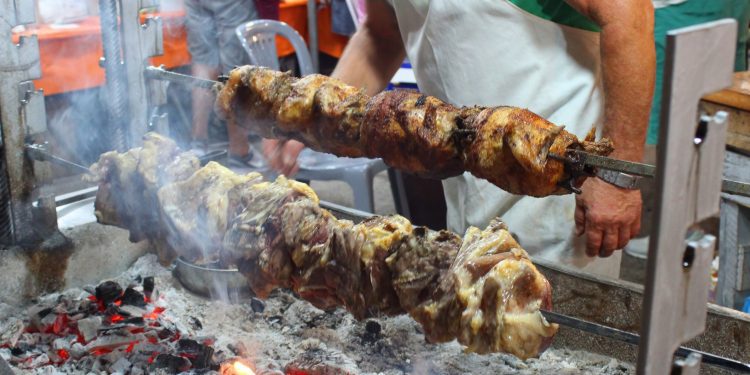Kontosouvli, one of Greece’s most beloved dishes, is a mouthwatering, slow-roasted meat that has captured the hearts and appetites of many. This dish, known for its tender and flavorful meat, has a rich history that spans centuries, evolving from a traditional village meal to a staple of modern Greek cuisine. Let’s take a journey through the history of Kontosouvli, exploring its origins, cultural significance, and how it has found its place on both local and international tables today.
1. The Origins of Kontosouvli: A Village Tradition
Kontosouvli, like many traditional Greek dishes, has its roots in the rural villages of Greece. The name “Kontosouvli” comes from the Greek words “konto,” meaning short, and “souvla,” meaning spit. This dish was traditionally made by skewering large pieces of pork (though lamb and chicken are also common) on a thick spit and slow-roasting them over an open fire.
In its earliest days, Kontosouvli was a meal reserved for special occasions and communal gatherings. Villagers would prepare the dish during festivals, religious celebrations, or family feasts, where the entire community would come together. The slow-roasting process was ideal for feeding large groups, as the meat could be cooked in large quantities and shared among many.
2. The Cooking Technique: Patience and Flavor
The preparation of Kontosouvli is as much about the process as it is about the ingredients. Traditionally, the meat is marinated in a mixture of olive oil, lemon juice, garlic, oregano, and other local herbs and spices. This marinade not only enhances the flavor but also helps to tenderize the meat.
Once marinated, the meat is skewered onto a large spit and cooked slowly over a charcoal fire. The slow-roasting technique allows the meat to cook evenly, with the fat rendering down and basting the meat as it turns, resulting in an incredibly tender and flavorful dish.
In many villages, the roasting of Kontosouvli is a social event in itself. Families and friends would gather around the fire, turning the spit by hand, sharing stories, and enjoying each other’s company while the meat cooked to perfection. This communal aspect of preparing and enjoying Kontosouvli is a key part of its cultural significance.
3. Regional Variations: A Taste of Local Flavors
As with many traditional dishes, Kontosouvli has regional variations that reflect the diverse culinary landscape of Greece. While pork is the most common meat used, in some regions, lamb or goat may be preferred, especially in areas with a strong tradition of shepherding.
- Central Greece and Thessaly: These regions are particularly famous for their Kontosouvli, where it is often made with large chunks of pork and flavored with plenty of garlic and oregano. The meat is usually served with roasted potatoes and a squeeze of fresh lemon juice.
- Epirus: In the mountainous region of Epirus, lamb Kontosouvli is more common. The lamb is often seasoned with wild herbs from the mountains, giving it a unique and robust flavor.
- Peloponnese: Here, you might find Kontosouvli made with a mix of meats, including pork, lamb, and chicken, all cooked together on the same spit. This blend of flavors creates a rich and satisfying dish that is perfect for large gatherings.
These regional variations showcase the adaptability of Kontosouvli and its ability to reflect the local tastes and traditions of different parts of Greece.

4. Kontosouvli in Modern Greek Cuisine
In recent decades, Kontosouvli has transitioned from a village specialty to a popular dish found in tavernas and restaurants across Greece. Its rise in popularity can be attributed to the growing interest in traditional Greek cuisine, as well as the desire to preserve and celebrate these culinary traditions.
Today, you can find Kontosouvli served in a variety of settings, from casual street food stalls to upscale restaurants. While the traditional preparation method remains the gold standard, modern variations have emerged, with chefs experimenting with different marinades, meats, and serving styles.
In urban areas, particularly in Athens and Thessaloniki, Kontosouvli is often served as a street food, with the meat sliced off the spit and served in pita bread with tomatoes, onions, and tzatziki, similar to a gyros. This portable version has made Kontosouvli accessible to a new generation of food lovers who appreciate its rich flavor and satisfying simplicity.
5. The Global Spread of Kontosouvli
As Greek cuisine has gained international recognition, so too has Kontosouvli. Greek restaurants around the world now feature this dish on their menus, introducing it to a global audience. The appeal of Kontosouvli lies in its simplicity and the universal love of well-cooked, flavorful meat.
Food festivals, cooking shows, and culinary tourism have also played a role in spreading the love for Kontosouvli beyond Greece’s borders. Visitors to Greece often return home with fond memories of the dish, seeking out local Greek restaurants or attempting to recreate it in their own kitchens.
6. How to Enjoy Kontosouvli Today
Whether you’re in a small Greek village or a bustling city, enjoying Kontosouvli is a must for any food lover. To experience it at its best:
- Seek Out Local Taverns: Look for traditional taverns, especially in rural areas or small towns, where the preparation of Kontosouvli remains close to its roots. These establishments often serve the dish in generous portions, accompanied by local sides like roasted potatoes, fresh salads, and homemade bread.
- Try It at a Greek Festival: Many Greek festivals, both in Greece and abroad, feature Kontosouvli as a centerpiece of their culinary offerings. The festive atmosphere and communal spirit make it a perfect setting to enjoy this traditional dish.
- Make It at Home: If you’re feeling adventurous, try making Kontosouvli at home. While you might not have a large spit, you can replicate the flavors by slow-cooking marinated meat on a grill or in the oven. Serve it with a Greek salad, tzatziki, and pita bread for a complete meal.
Conclusion: A Timeless Greek Tradition
Kontosouvli is more than just a dish; it’s a symbol of Greek culture and hospitality. From its humble beginnings in rural villages to its place on modern tables around the world, Kontosouvli continues to be a beloved part of Greece’s culinary heritage. Whether you’re enjoying it at a local taverna, at a festive gathering, or in your own home, Kontosouvli offers a taste of Greece’s rich history and vibrant flavors. So next time you’re in Greece—or even if you’re just dreaming of it—be sure to savor the delicious tradition of Kontosouvli.











